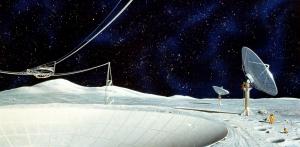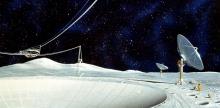Moon and Saturn [1]
When Apollo astronauts orbited the Moon, they had some quiet time. When they passed behind the Moon, the Moon’s bulk blocked radio chatter from Earth.
That quietness could be good for astronomy in the decades ahead. Radio telescopes on the lunar farside could study the early days of the universe, when the first stars and galaxies were being born.
Astronomers have studied the possibility of placing telescopes on the Moon for decades. Better technology has made it easier to send telescopes into space, though, reducing the need for lunar telescopes.
But one area where the Moon might still have an advantage is studying long radio waves. Earth’s atmosphere blocks some of these waves. And satellites, cell phones, and other technology creates interference.
Astronomers are interested in these waves because they were emitted by the first stars and galaxies, when the universe was less than a billion years old. The expanding universe has stretched them to much longer wavelengths.
Radio telescopes on the Moon could catch these waves. The telescopes would consist of arrays of long antennas spread across many miles. Shielded from terrestrial interference by the Moon, they could provide new insights into the birth of the stars.
Look for the Moon and a bright companion the next couple of mornings. The planet Saturn will be close to the upper left of the Moon at first light tomorrow, and closer to the right of the Moon on Thursday.
Script by Damond Benningfield

